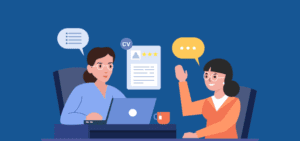Category: Interview Preparation
-

A Software Developer’s Journey: Navigating a Mock...
Continue ReadingInterviewer: Good morning. Thank you for coming in today. Let’s start with a brief introduction. Can you tell us about your background and experience as a software developer?
Candidate: Good morning. I have a Bachelor’s degree in Computer Science and have been working as a software developer for the past five years. I’ve primarily focused on web development, working with technologies such as JavaScript, React, and Node.js. I’ve also had experience with database management using SQL and NoSQL databases.
Interviewer: That sounds great. Let’s dive into some technical questions. Can you explain what RESTful APIs are and why they are important in web development?
Candidate: RESTful APIs, or Representational State Transfer, are a set of architectural principles for designing networked applications. They use HTTP methods like GET, POST, PUT, and DELETE to perform CRUD operations (Create, Read, Update, Delete) on resources. RESTful APIs are important in web development because they provide a standardized way for different systems to communicate over the internet. They are stateless, scalable, and allow for easy integration between various platforms and services.
Interviewer: Excellent explanation. Now, let’s talk about front-end development. Can you explain the concept of “state” in React and how it’s managed?
Candidate: In React, “state” refers to any data that should be saved and maintained for a component. It represents the current condition or data of a component and can change over time. State is typically initialized in a constructor or by using the `useState` hook in functional components. To manage state changes, React provides methods like `setState` for class components and `useState` for functional components. When state changes, React re-renders the component to reflect the updated state.
Interviewer: Great explanation. Now, let’s shift to problem-solving. Can you solve a coding problem for us? Here’s a simple one: Write a function in Python to reverse a string.
Candidate: Certainly. Here’s a Python function to reverse a string:
“`python
def reverse_string(input_str):
return input_str[::-1]
“`Interviewer: Well done. Now, let’s discuss your experience with version control. Can you explain the purpose of Git and how it benefits software development?
Candidate: Git is a distributed version control system that allows developers to track changes in their codebase. It provides benefits such as:
1. Version History: Git maintains a complete history of code changes, making it easy to track when, how, and why changes were made.
2. Collaboration: Multiple developers can work on the same project simultaneously by creating branches, and Git helps merge their changes seamlessly.
3. Backup: Git serves as a backup system for code, ensuring that data loss is minimal.
4. Branching and Merging: Developers can create feature branches to work on specific tasks and merge them back into the main branch when completed.Interviewer: Impressive. Lastly, can you tell me about a challenging project you’ve worked on and how you overcame difficulties during its development?
Candidate: Certainly. In a previous role, I was part of a team developing a real-time chat application. One challenge we faced was handling high concurrency and ensuring low latency. To overcome this, we optimized our code for performance, implemented efficient data structures, and used WebSockets for real-time communication. We also conducted load testing and profiling to identify bottlenecks and fine-tuned our system accordingly. In the end, we achieved our performance goals and delivered a highly responsive chat application.
Interviewer: That’s an excellent example of problem-solving in a real-world scenario. Thank you for sharing that. We’ve come to the end of our interview. Do you have any questions for us?
Candidate: Yes, I do. Can you tell me more about the team I’d be working with and the projects currently in progress?
Interviewer: Of course. We’ll provide you with that information after the interview. Thank you for your time today. We’ll be in touch soon.
Candidate: Thank you for the opportunity. I look forward to hearing from you.
This mock interview covers various aspects of a developer’s skills and experiences, including technical knowledge, problem-solving abilities, and interpersonal skills. It demonstrates how a candidate can effectively respond to common interview questions in a developer job interview.
-


Dressing for Success: An Effective Dress Code...
Continue ReadingJob interviews are your chance to make a lasting impression on potential employers. Beyond showcasing your qualifications and skills, your appearance plays a vital role in creating a positive first impression. An effective dress code for interviews can help you convey professionalism, confidence, and a genuine interest in the job. In this article, we’ll explore the key elements of dressing for success in interviews.
Research the Company Culture: Before selecting your interview attire, research the company’s culture and industry standards. Dress codes can vary significantly from one workplace to another. Some companies have a formal dress code, while others embrace business casual or even casual attire.
Opt for Professional Attire: In most cases, it’s best to err on the side of caution and dress professionally. For men, this typically means a well-fitted suit, dress shirt, tie, and polished dress shoes. Women can choose between a pantsuit, skirt suit, or a conservative dress with closed-toe shoes. Ensure that your attire is clean, wrinkle-free, and well-maintained
Colors Matter: Stick to classic, neutral colors such as black, navy, gray, or beige for suits and clothing. Bright or overly trendy colors can be distracting, so it’s best to keep your attire understated.
Grooming Matters: Personal grooming is as crucial as clothing. Ensure you are clean-shaven (if applicable), have well-kempt hair, trimmed nails, and fresh breath. Minimal, subtle makeup and accessories are preferable.
Footwear: Your choice of shoes should complement your outfit. Closed-toe, leather or faux-leather shoes are generally the safest option. Ensure they are polished and in good condition.
Avoid Overdoing Fragrances: It’s essential to be mindful of fragrances. Excessive perfume or cologne can be overpowering and may not be appreciated by interviewers or colleagues with sensitivities.
Appropriate Fit: Ill-fitting clothing can undermine your professionalism. Make sure your attire fits well and doesn’t bunch, sag, or feel too tight.
Minimal Accessories: Keep jewelry and accessories to a minimum. A simple watch, stud earrings, and a conservative tiepin or scarf are usually sufficient. Remove any piercings or jewelry that could be seen as excessive or distracting.
Bring a Portfolio or Briefcase: Carry a professional portfolio or briefcase to hold copies of your resume, references, and any other documents. Avoid carrying a backpack or overly casual bag.
Practice Makes Perfect: Try on your interview outfit in advance to ensure everything fits well and looks appropriate. Practice walking and sitting comfortably in your chosen attire to avoid discomfort during the interview.
Conclusion: Dressing for a job interview isn’t just about looking good; it’s about conveying professionalism, respect, and seriousness about the opportunity. An effective dress code for interviews is one that aligns with the company culture, industry norms, and the role you’re seeking. Remember, the goal is to make a positive impression and create confidence in your potential as a valuable addition to the organization. So, choose your interview attire wisely and step into your next interview with confidence and style.

